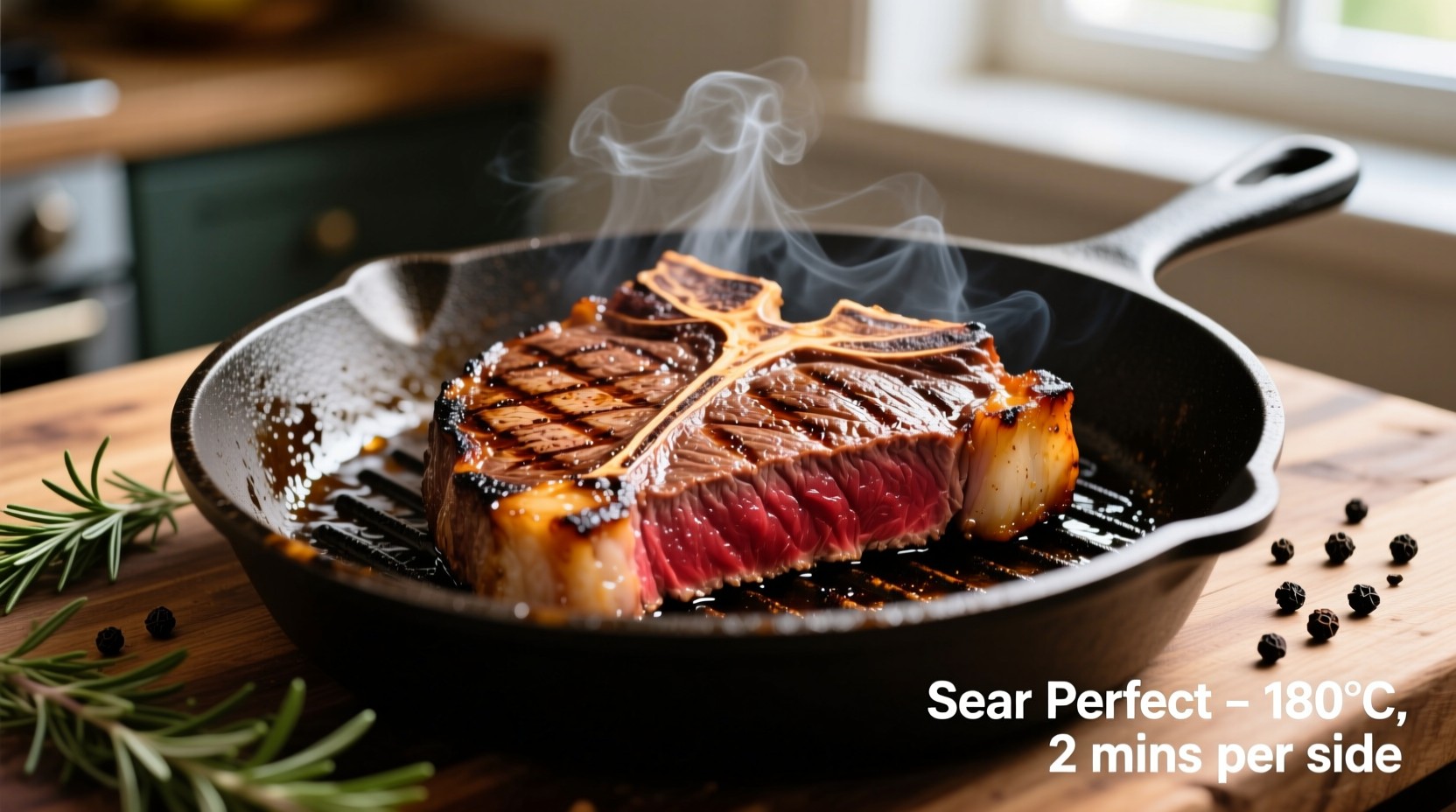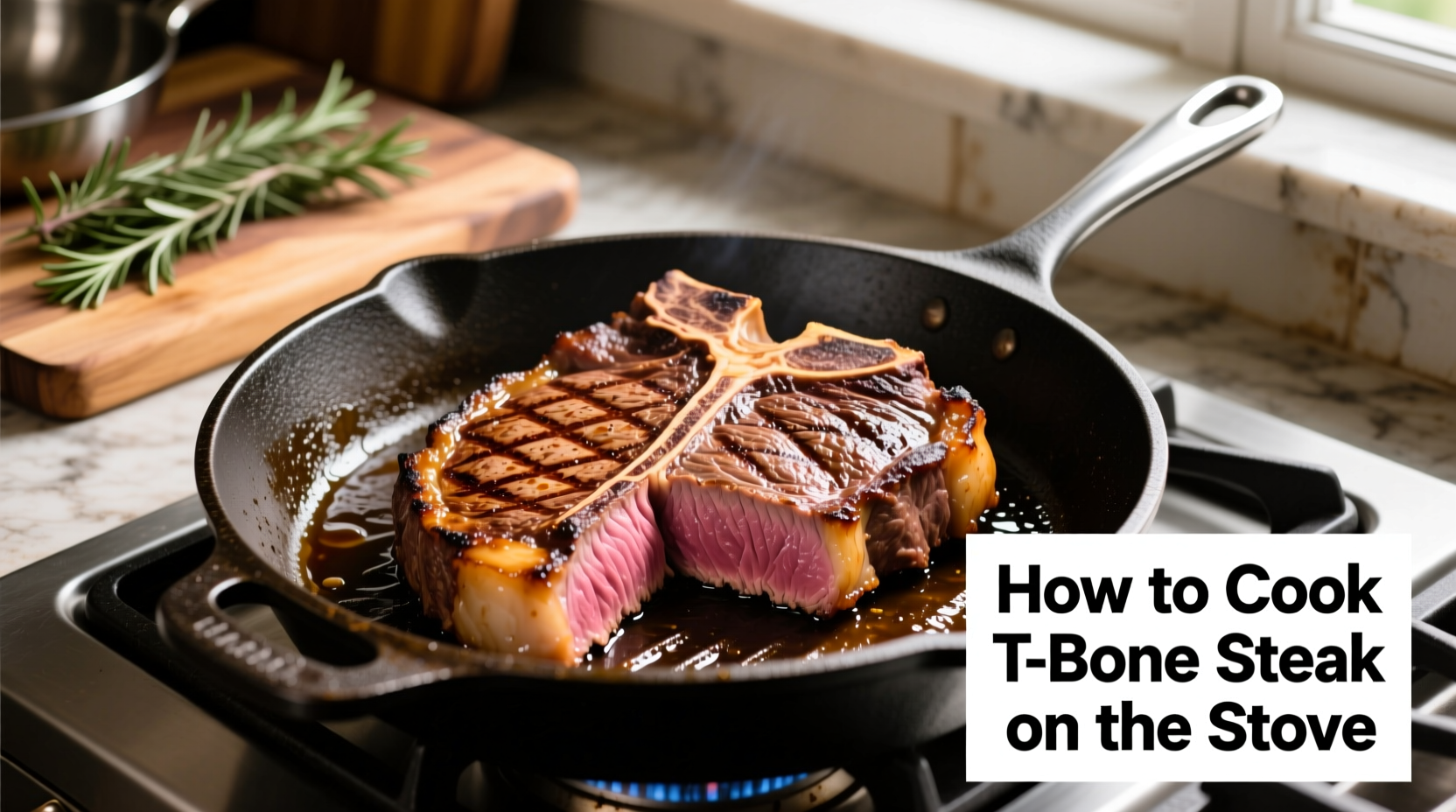The perfect method for cooking t-bone steak on the stove involves preheating a heavy skillet to 400-450°F, seasoning the steak generously, searing for 3-4 minutes per side, then finishing in a 400°F oven for 6-10 minutes depending on thickness and desired doneness. Always rest for 5-10 minutes before serving. This technique delivers a flavorful crust while maintaining juicy, evenly cooked meat.
Why Stovetop Cooking Creates the Perfect T-Bone Steak
Cooking t-bone steak on the stove combines the intense heat needed for proper searing with precise temperature control that grills or outdoor methods can't always provide. The t-bone's unique structure—with both tenderloin and strip portions—requires careful attention to ensure both sections cook evenly. Professional chefs prefer this method because it creates that essential restaurant-quality crust while maintaining perfect internal temperature control.
Essential Equipment and Ingredients Checklist
Before you begin, gather these critical items to ensure success:
- 1-1.5 inch thick t-bone steak (14-16 oz)
- Heavy-bottomed cast iron or carbon steel skillet
- High smoke point oil (avocado, canola, or grapeseed)
- Instant-read thermometer (critical for accuracy)
- Meat thermometer
- Salt (preferably coarse kosher salt)
- Freshly ground black pepper
- Butter, garlic, and fresh herbs (optional for finishing)
| Doneness Level | Internal Temperature | Visual & Texture Indicators |
|---|---|---|
| Rare | 120-125°F (49-52°C) | Cool red center, very soft to touch |
| Medium Rare | 130-135°F (54-57°C) | Warm red center, soft with slight resistance |
| Medium | 140-145°F (60-63°C) | Warm pink center, firm but yielding |
| Medium Well | 150-155°F (66-68°C) | Small amount of pink, fairly firm |
| Well Done | 160°F+ (71°C+) | Little to no pink, very firm |
Source: USDA Food Safety and Inspection Service temperature guidelines for beef
Step-by-Step Cooking Process
Preparation Phase (30-60 Minutes Before Cooking)
Remove your steak from the refrigerator 30-60 minutes before cooking. This critical step brings the meat to room temperature, ensuring even cooking. Season generously with coarse salt and freshly ground black pepper on all sides. The salt begins breaking down proteins, enhancing tenderness and flavor penetration. Professional chefs at the Culinary Institute of America recommend this resting period for optimal results.
Searing Process (The Foundation of Flavor)
Preheat your cast iron skillet over medium-high heat for 5-7 minutes until it reaches 400-450°F. Add 1-2 tablespoons of high smoke point oil. When the oil shimmers but doesn't smoke excessively, carefully place the steak in the pan. For a 1.5-inch thick steak:
- Sear undisturbed for 3-4 minutes to develop a deep brown crust
- Flip and sear the other side for another 3-4 minutes
- Use tongs to sear the edges for 1 minute per side
During this phase, the Maillard reaction creates complex flavor compounds. Don't move the steak while searing—this allows proper crust development. If flare-ups occur, temporarily remove the pan from heat.

Finishing to Perfect Doneness
For steaks thicker than 1 inch, transfer the skillet to a preheated 400°F oven:
- Rare: 4-6 minutes
- Medium rare: 6-8 minutes
- Medium: 8-10 minutes
Monitor internal temperature closely using an instant-read thermometer. Insert horizontally into the thickest part of the strip section (not the tenderloin side). Remove steak when 5°F below your target temperature, as carryover cooking will raise the temperature during resting.
Resting: The Critical Final Step
Transfer the steak to a cutting board or warm plate and tent loosely with foil. Rest for 5-10 minutes (5 minutes for 1-inch, 10 minutes for 1.5-inch steaks). This allows juices to redistribute throughout the meat. Cutting too soon releases precious juices onto the plate instead of staying in the steak.
Common Mistakes That Ruin Stovetop T-Bone Steaks
Avoid these frequent errors that turn premium steak into disappointment:
- Skipping the preheat: A properly preheated pan creates instant sear without overcooking
- Overcrowding the pan: Cook one steak at a time for proper heat retention
- Moving the steak too soon: Wait until it releases naturally from the pan
- Guessing doneness: Always use a thermometer—finger tests are unreliable
- Cutting too soon: Resting time is non-negotiable for juicy results
When Stovetop Cooking Outperforms Other Methods
The stove-to-oven method particularly excels for t-bone steaks due to their unique structure:
- Thicker cuts (1.25 inches or more) where direct heat alone would overcook the exterior
- Cold weather when outdoor grilling isn't practical
- When precise temperature control is needed for consistent results
- Apartment living without outdoor cooking options
According to chef instructors at the American Culinary Federation, this method provides superior control for achieving even cooking across both the tenderloin and strip sections of the t-bone, which have different densities and require slightly different cooking approaches.
Troubleshooting Guide
- Burning exterior, raw interior: Pan too hot; reduce heat slightly next time
- Steak sticking to pan: Pan not hot enough or moved too soon
- Uneven cooking between sections: Rotate steak 180° during searing phase
- Excessive smoke: Use proper ventilation or slightly reduce heat
- Dry texture: Overcooked or insufficient resting time











 浙公网安备
33010002000092号
浙公网安备
33010002000092号 浙B2-20120091-4
浙B2-20120091-4